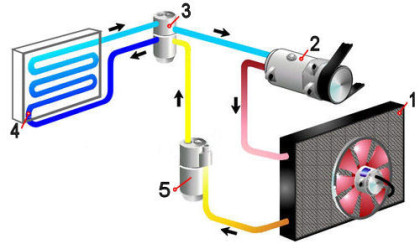mobile vehicle air conditioning servicing, diagnostics and repairs
Vehicle Air Conditioning explained
Basic Expansion valve type system
1) Condenser
2) Compressor
3) Expansion valve
4) Evaporator
5) Receiver/Dryer
The Air Conditioning system has a high pressure side, and a low pressure side. The high pressure side is between the outlet side of the compressor and the inlet side of the expansion valve. The low pressure side is between the outlet side of the expansion valve, to the inlet side of the compressor.
High pressure.
The cycle starts at the Compressor. The Compressor (which is driven by the engine via a drive belt) compresses the refrigerant gas, which causes the refrigerant gas to become high pressure and high temperature. As the refrigerant gas passes through the Condenser (Assisted by the cooling fan if needed), the refrigerant temperature drops which causes the refrigerant gas to condense into a cooler temprature liquid refrigerant. The liquid refrigerant then passes through the Receiver/Dryer which is basically a filter and moisture trap combined. The liquid refrigerant then reaches the Expansion valve which acts as a temperature controlled restriction, this is the end of the high pressure side.
Low pressure.
As the refrigerant leaves the expansion valve, on it's ways to the Evaporater, it instantly drops in pressure and therefore temperature. The refrigerant is now a very low temperature vapour rather than a liquid or a gas. The Evaporator now becomes very cold and as the interior fan motor blows air accross it, cold air blows out of the vents. As the refrigerant travels through the Evaporator it absorbs the heat from the vehicle's interior and returns to compressor as a low pressure, low temperature gas where the cycle can start again.
Note: This is just a simple explanation of one system design, but all variations operate to the same basic principles.


